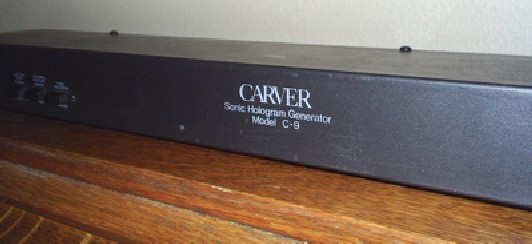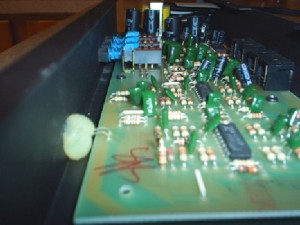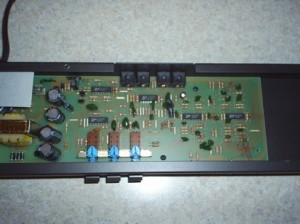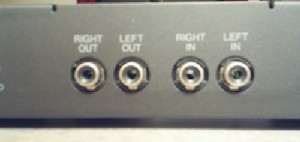The 1980s were an interesting time in audio. The integrated chip, for better or worse, became the standard piece on the motherboard. To some, this was the point at which audio began what they believe was the death spiral. To others, the IC allowed the industry to try new things. One area in which many saw potential was the area of sound shaping. Up to this time, audio fans were pretty much limited to the “advanced” controls of the equalizer. A new term sprung up, sonic holography, the idea that two speakers could, in fact, create a three-dimensional sound spot somewhere in front of the speakers. A couple of approaches to this concept sprung forth. Matthew Polk believed that using actual signals from the speakers to cancel out crosstalk was the way to go. He brought his ideas to life in his SDA speaker series.
Specifications:
- Built from: 1981-89
- Measurements: 17.25w X 4d X 1.75h
- Used pricing: $50-100
- Made in the USA
The other approach came from Bob Carver, who believed that the IC could be programmed to eliminate crosstalk thru signal alteration. Wikipedia.com explains it thus, for better or worse:
The goal of sonic holography is to remove distortions in pitch caused by the doppler effect while recording and playing back audio on a sound system. While an audio source is recorded by a microphone, the membrane that picks up sound vibrations moves towards and away from the source. This results in a doppler shift that is preserved in the recording. When that recording is played through a speaker, the cone vibrates back and forth in order to move air particles and create sound. This introduces a second doppler shift, especially when the same cone is producing multiple frequencies at the same time. Both instances of doppler distortion degrade the overall quality of the output. Sonic holography attempts to remove these distortions using a proprietary filter designed by Bob Carver.
Playing around with the signal in this fashion infuriated the audio purists of the day. The younger audio crowd (including myself) had a more open mind about the process. In the 1980s, I looked at the end result rather than the journey of an audio signal. With that statement in mind, during a long winter in Cheyenne, Wyoming, I managed to acquire a C9. It was my way of having SDA technology while keeping my Polk Monitor 10’s. In thinking back twenty-one years, I remember that not every album or cd sounded better. But the C9 did change the sound. With not a lot else to do in Cheyenne after work on weeknights, I quickly went thru my music collection and memorized which albums to engage the sonic holography. Typical of Cheyenne, it was a long and windy winter and I had experimented with the c9 quite a bit. By the summer of 1987, I had tired of engaging/disengaging the C9, and used it as partial payment for a Conrad Johnson PV7 preamp.
This past fall, I was e-mailing with a reader, and he mentioned the C9 and that it would be a good review piece. With that suggestion in mind, I began watching eBay and Craigslist. Last month my vigilance paid off. I spotted a Carver C9 on eBay on a Buy It Now auction for just $55 plus shipping. Even better, it came from just 100 miles away. The seller was kind enough to knock shipping down to only $8. Figuring I could resell it for the same price, I bought it without hesitation.
The Build
The Carver C9 is a wide, low-profile unit with a short depth. Its dimensions and light weight make it a bit awkward for those who employ heavy RCA interconnects, as in certain setups it can actually tip the front side of the C9 upwards. This shouldn’t give the impression that the C9 is flimsy. In reality, the steel gauge is quite substantial, with very little flex once the top is removed.
The front panel has just three buttons: Injection Ratio (normal or theoretical), Listening Aperture (narrow or wide), and Sonic Hologram (bypass or engage). To the right of center, is a small red power LED. The backside consists of two pairs of RCA jacks, one pair each for input and output. On the far left is a power cord and a switched outlet.
Listening
I placed the Carver C9 between my Jolida cdp and the integrated amplifier (either the Underwood modified PS Audio Trio C100 or Onix SP3). What little Internet information was available did remind me that for the C9 to work best, the speakers need to be only 6 feet apart, with a slight toe-in, and well away from any walls. I started my demo cd with all three buttons in the out position. About thirty seconds into the initial track I engaged the sonic hologram. The difference was obvious, the music came from a wider point, but also I heard the faint sonics of music coming from a well. I pulled the speakers out another 6-8 inches from the back wall. I also went and grabbed a dining room chair which placed me about 3 feet closer to the speakers. That helped a little, but I was still frustrated.
Remembering that not all music sounded great with the C9 in Cheyenne, I dug deep into my collection and pulled out The Who, Who’s Next, and proceeded to play “Baba O’Reilly.” Bingo! The sonic holography appeared. A thirtyfive-year-old recording had a new life. Playing it a second time through, I set the aperture to “wide.” Big mistake, the sound became almost warped, for lack of better wording. I quickly went back to “narrow” and sonic bliss returned.
Hoping for a better result, I next tried changing the Injection Ratio, from Normal to Theoretical. The sound became rather similar to a distant echo. Once again, I returned that switch to its original position. At least I now knew the sonic limits, based on my room environment and equipment.
I played a wide variety of music, and after several days a pattern emerged. Older rock music was by far the most enjoyable. Light rock was very hit and miss, to the point that different tracks on recordings were either pleasant or plain awful. Classical was the most disappointing: only two passages from a sampler disc were worth listening to.
Final Thoughts
It was a great deal of fun stepping back the twenty plus years to relive my audio youth. The Carver C9 is a fun piece of equipment, but a frustrating one as well–not because of its own shortcomings, but because it is so dependent on the source material. Therefore, if you’re a fan of classic hard and arena rock from the 1970’s, the C9 may just be an enjoyable addition to your system.
 from affordableaudio, By Mark Marcantonio
from affordableaudio, By Mark Marcantonio




Just won a C-9 on eBay. Was fascinated by it 25 yrs agi, and forgot about it. Then couldn’t remember who made it. Thought it was Harman Kardon but nothi g showed up. Figured it out and ow I’m awating it’s delivery. Your article was great. Hope Brian Auger sounds good on the C-9!
I have one of these. I bought it new back in (I think) 1981 or ’82. I think you nailed it, it’s a nice toy to tinker with, and it CAN make some otherwise bland recordings come to life (works wonders on Best of the Doobies, Black Water). But other than just a play thing, it’s just a bit of nostalgia that I never got rid of.
Best results with Carver sonic holography come with recordings made with two mics, with little or no post-processing. This is because s.h. basically reverses the transform that occurs when you record under those conditions. Binaural recordings sound best.
The C-9 is one of the most useful additions any audiophile can add to his rack. The sonic effect is amazing, if albeit limited in seating locations between the speakers. I have a home theater system where the front left and right speakers are processed through Sonic Holography and the audio cues are so realistic that I once looked over my shoulder in the middle of a horror movie because I swore somebody was opening the door behind me! LOL
In the Boston area, station WCOZ broadcast Pink Floyd’s Dark Side of The Moon with the bigger C275(?) on line. Admittedly, the speaker setup is crucial, but once it was properly set up I could perceive a person running from around 6 feet outside the wall. I watched the original Predator with this and perceived rustling in the bushes from outside the room boundaries. It is a shame Bob’s technology didn’t take off.
I too felt the same regarding Sonic Holography when first encountered on my C1 purchased ~’86. However, I recently revisited it for use with my newly-acquired Acoustat 1+1 electrostatics with Medallion (red) Mod and have been mesmerized at how every recording from every genre is dramatically improved in its already open and free soundstage. I suspect the exacting setup and constrained listening position requirements of the Acoustats lend to the ubiquitous success of Sonic Holograpy in this environment.
Bob Carver was a dreamer who dared to tear down status quo norms, with sometimes miraculous results.
Wow, Acoustats and a C1 sounds like a great set up.
I’ve had the C1 , two Carver 450 for my ADS 1530s. I’ve had this set up since 1982. I recently refinished my basement and have my speakers on the long wall. Also followed Bob’s original detailed notes on setting up the environment. Huge difference. Recommend taking a listen to Strawberry Fields and the string section will stand out beautifully. Agree with The Who stuff. For a real treat, check out Kind of Blue.
” It is a shame Bob’s technology didn’t take off.”
I think it might actually have done — in an unexpected way.
At this moment, I’m typing this on an HP laptop with B&O sound, and they’ve got some circuitry in there that’s achieving the *identical* wider-than-the-speaker-width soundscreen that Carver’s Sonic Hologram gave us back in the day.
I can’t think of any other way to accomplish this than Carver’s crosschannel-cancellation method (which, iirc from the before-time, has less than nothing to do with Doppler shifts or interference in mic’s or speaker cones; so much for Wikipedia editors), so I’ve concluded that B&O has either licensed that tech from Carver, or poached it.
Came here to this site on a Google search for “did Bang & Olufsen license Carver’s sonic hologram tech?”
This site was the first hit, but no joy.
Oh well; on to the next site — of 21.9k…
I had a C9 for several years. Was never able to set up speakers per the instructions. A marker of practicality on the room available. Still, the effect was evident with bookshelf speaker actually on a bookshelf and last of books crammed around them. This made them sort of flush with a sort of irregular wall, i.e. A situation that tends to break up reflections. Later I used it with Magnepans and got spectacular results usually. I suspect any dipole speaker (electrostatics or LinkwitzLab) would get similar results. The common thread is to diminish side reflections I think.
“The Carver C9 is a fun piece of equipment, but a frustrating one as well–not because of its own shortcomings, but because it is so dependent on the source material.”
…and ironically this is why sound shaping equipment is actually quite handy because most sound recordings have been subjectively produced.
Iit took years for me to shed the audiophile arrogance of straight-wire-with-gain and that it is somewhow my warped obligation to listen to a recording as the sound engineers intended.
No! I like to listen to music how it impacts my ears, listening experience, and emotions. If that takes “sound shaping” equipment – be it tone controls, a subwoofer, crossover unit, or equalizer – so be it.
If you want to live life shackled and not allow yourself to put a dash of salt and pepper in watery soup then enjoy being sugject to someone else’s tastes. Me I’ll spice up life with an equalizer, and tone controls for my music and some hot sauce in my soup!
I added the C-9 to my system years ago & am still loving it! Speaker placement is crucial to optimal listening. I have been searching for some new music to listen to, that’s how I wound up here. Santana Abraxis is prolly the best entire cd besides Pink Floyd, Dark Side of the Moon.
Pink Floyd’s The Wall is phenomenal with theoretical setting on the SH, definitely my favorite recording with the circuit engaged. One recording from Radiohead, again with the theoretical setting, – Planet Telex off The Bends album is so omnidirectional it sounds like the 4 walls and ceiling are all generating sound, played at high volume it is almost frightening as if the whole house is a living breathing entity.
I had a Carver Receiver paired with the C-9 generator back in the 80’s. The first two setups were with ADS 1290 speakers in two asymmetrical rooms in two different homes. The effect was airy and open, but not anything special. Fast forward to 98. I try the C-9 again in a new home with symmetrical dimensions. This time I use tiny Polk audio satellites with a sub. The effect was nothing short of miraculous!! The soundstage expanded beyond the speakers to around the corners. The speakers were only 4ft apart and sitting on top of a cabinet 5.5 ft above the floor. The speakers were two feet from the back wall and slightly toed in. All listeners could not believe what they were hearing and instinctively would look for more speakers! Lol
I’m using the Sonic Holography option in my Carver Sunfire TGP 5 pre-pro with Ohm Walsh 1000’s and HSU subwoofer, and to me it makes the difference between listening to music (w/o the hologram) and experiencing it (w hologram).
From the above comments I surmise that it works better with dipole or omni/semi directional speakers than with direct radiating.